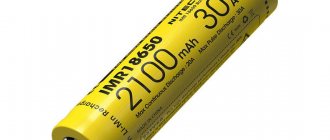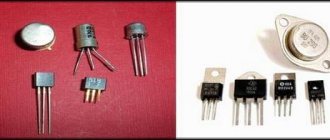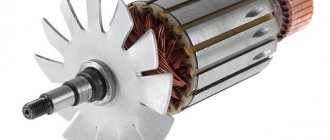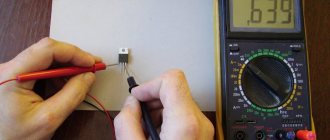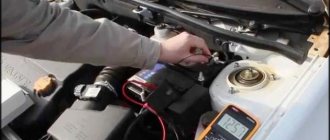The actual capacity of a lead-acid battery is one of its most important characteristics, which inevitably decreases from the moment it is purchased and installed on the car. Its measurement during operation allows you to clearly assess the current state of the battery, even if the results obtained are not highly accurate. This can be done in several ways, some of which are very simple and easy to do independently in a basic garage.
Methods for determining capacitance indicators
We will describe the most common ways to check the capacity of a car battery. These 2 methods have proven themselves to be the best and are widely used today.
Long Discharge Method
This method has found its application in laboratory conditions. There are also a household method and a method based on long-term charging. Let's take a closer look at all three:
- Standard method (laboratory). To check, the battery must be charged as much as possible and discharged using a minimum current. At the same time, the amount of time during which the discharge occurs is taken into account. The battery capacity, as described above, is nothing more than the product of time and current strength. The complexity of measurements in this case depends on maintaining a constant current discharge using specialized equipment, which is why the method is laboratory.
- Household method. You can check the battery capacity using a constant load. In this case, they use car lamps, creating a load with their help. By analogy with the first method, the time is calculated in parallel in hours. This procedure has its own error, since the load current gradually decreases and the final result of determining the capacitance is not entirely accurate. It is worth noting that the power source should not be allowed to completely discharge, as this may cause it to fail.
- Method based on long-term charging. In this case, an electronic clock and the electrical circuit to which it is connected are used. The diagram itself can be easily found on the Internet. Measurements are carried out over 20 hours.
Method using an electronic tester
This method compares favorably with others in that it is carried out in a shorter period of time. To carry it out, you will need a special device - a tester, which can simultaneously analyze a series of necessary measurements.
The testers operate automatically and do not require special knowledge from the person taking the measurements. Its operating time takes only 10 – 15 seconds. The device easily connects to a power source and has only one button that starts the capacitance measurement process.
The selection of a battery is made based on a comparison of the residual capacity and the nominal capacity, which is indicated by the manufacturer in the battery passport. The difference should not exceed 50%, otherwise such a power source is not ready for further use.
Multimeter method
This device allows you to measure not only battery capacity, but can also be used as an ohmmeter and voltmeter. Measuring the battery capacity with a multimeter is not difficult if you follow the following steps exactly as they are listed below:
- The device must be switched to continuous measurement mode.
- Next, a range is established that is slightly larger than that stated in the battery passport.
- A special black probe is connected to the socket (-).
- The red probe is connected to the socket (+) in the same way.
- The readings are read and displayed.
- At the end of the measurement procedures, the electrical circuit is disconnected.
This text provided comprehensive answers to questions such as: what is needed in order to measure the battery capacity? How to measure? How to find out or how to determine capacitance indicators? The most popular methods and methods of measurement were described. All this information will be useful to every car enthusiast, because knowledge in this area will help in the future when choosing a specific battery. A charger and these skills will keep your power source in working condition much longer.
▍Autool BT360
Autool BT360
is similar to All-sun EM571 not only in its body, but also in its interface. It all starts with choosing a language, then the same points follow.
All the same two algorithms, nothing new. When checking the Topla AGM in normal battery mode, it showed 100% health, in AGM mode - only 92%, despite the fact that the starting current is normal.
Checking battery capacity with a multimeter Electrician
How to check the battery capacity with a multimeter
Each lead-acid battery loses its maximum capacity and performance properties over time; a deposit of lead sulphate salts forms on the plates - sulfation. The amount of acid per percentage of electrolyte becomes less and naturally the density of the electrolyte decreases.
How can I check my battery?
Electrolyte density is the oldest and most popular method, but modern sealed batteries do not have holes for checking in this way. With this method you can only learn a little about the general condition of the battery and its immediate future.
Using a load fork. It is a handle with two probe terminals that last for 1 sec. connected to the battery contacts. The device contains a voltmeter scale and a load that is designed for a certain battery capacity (car battery). The device shows the voltage under load and, depending on the readings of its arrow, one could judge the health of the battery.
A lead-acid battery tester is an electronic device that can show many battery parameters in a few seconds (up to 3 seconds), the main ones being: current, voltage, capacity, forecast for battery life.
Test discharge - well, the drawback is that the battery must be fully charged and its operation (discharge) must be checked for a long time using a known load. This takes a lot of time and wastes battery life.
Checking the battery using improvised means
On some models, an even lower current parameter is indicated (for example, this inscription - Initial current less than - 2.1A) based on this, we take this figure 2.1 * 12 volts = 25 Watt - this is the operating load power of the battery.
Now we need a load average between the operating and half of the maximum capacity, this is approximately 35 Watt, if the operating current is not specified, you can take 40 W. A light bulb (but another similar current load is also possible) of 12 volts is best suited as a load and a power of 35-40 W.
So, we connect the light bulb to the battery terminals for a period of 2 minutes and see if the light bulb changes brightness; if the light dims during this time, then the battery is faulty. If everything is unchanged, then after reaching 2 minutes of illumination, we connect a voltmeter (multimeter) to the glowing light bulb. and look at the voltage:
- more than 12.4 volts - the battery has retained its nominal capacity and is fully operational.
- 12-12.4 volts - the battery is serviceable but already tired
- less than 12 volts - the battery has already lost 50% of its rated capacity and it is better to replace it.
You should be sure that the battery is fully charged; it is best to charge it over the course of a day or at least 6 hours with an appropriate current.
How many ampere hours are in a car battery?
Since the capacity of a battery is one of its most important parameters, it is necessarily present in the labeling, and it is what they focus on first when making a purchase.
However, few people pay attention to such an indicator as reserve capacity. And completely in vain. If the rated capacity determines the magnitude of the discharge in the time axis when exposed to currents of small nominal value, then the reserve capacity indicates how long the battery will last in the event of a generator failure. The discharge current in such cases can reach impressive values of the order of 25 A (air conditioning and external lighting are sufficient).
Reserve capacity is also often included in the labeling, but here the scaling is different: instead of hours, minutes are indicated, so absolute numbers seem impressive.
Let's consider the factors that have the most significant impact on battery capacity. This is the level of load on the electric current consumption of the car and the design features of the battery.
We won't talk much about the first factor. Obviously, the higher the class of the car, the better equipped it is. This means that the load is higher, so a battery with increased starting current values is required.
For an ordinary city runabout, a battery with a capacity of 45 Ah is sufficient. Most mid-size cars require a 60-amp battery, while luxury cars and SUVs are often equipped with 75 Ah batteries.
Indeed, to start a small-displacement power unit (volume 1.0–1.2 liters), a starting current of up to 250 A is sufficient, but a 3.5-liter engine will not support such a battery - here you need a battery with a starting current of about 350–400 A of increased capacity.
As for the design features of the battery, they come down mainly to their weight and dimensions: the more massive and larger the battery, the larger the area of the plates and the active zone, which directly affects the battery capacity.
How to measure phone battery capacity programmatically
How to find out the manufacturing date of a battery
If you do not have a tester, you can measure the battery capacity of your smartphone using special applications. One of the best options for this is AccuBattery. The free version of the program has wide functionality and can calculate the operating parameters of the battery. You can download it from Google Play.
To test, install the program on your smartphone, and then discharge it until it turns off. Place your device on charge, turn it on and launch the application. In the "Charging" tab at the bottom, set the design capacity specified by the manufacturer if it is not displayed correctly. Leave the device to charge, preferably up to 100%.
When the smartphone is charged, you can go to the “Health” tab in the program. It displays the current capacity indicator, calculated based on data built into the charge controller in the phone. The program automatically calculates the degree of battery wear and displays it.
AccuBattery
If you keep AccuBattery in the background constantly, the application can generate wear graphs so you can determine how quickly the battery in your phone is degrading.
The downside of AccuBattery, like any analogue, is its high dependence on the accuracy of the smartphone’s on-board sensors. After all, calculations are carried out based on the voltmeter and ammeter readings built into the charge controller. If these sensors are inaccurate and distort information, then the final indicators will be incorrect.
Software methods work worst (or rather, do not work) with cheap Chinese smartphones in the price range of about $100. Such devices, in order to reduce costs, are often deprived of full-fledged sensors. If they exist (and any battery controller on a smartphone’s board can measure voltage and current), then there is no access to these sensors from the operating system. In this case, the program will not be able to measure the phone battery capacity.
In addition to testers and programs, there are more accurate ways to measure battery capacity. There are full-fledged testers for taking measurements on batteries disconnected from the smartphone. These are often used for testing, for example, round batteries of 18650, 14500 and the like formats.
LiitoKala Lii-500
By taking measurements with the battery disconnected from the smartphone, you will get the most accurate capacity readings. But since 90% of modern mobile phones are equipped with non-removable batteries that use a cable for connection instead of a contact pad (as was the case before), this method of measuring capacity is not applicable for them.
▍TooL it DBT300
TooL it DBT300
readings are also not included on one screen; you need to scroll between three. The tester works faster than the previous ones. Unlike all of them, it is not Russified. The LCD screen is not a dot matrix, but a segment one. SoH and SoC are displayed in one place on the screen, which is inconvenient to read and can lead to confusion. This device does not have a “back” or “cancel” button; if there is an input error, you need to continue further, or reconnect the crocodiles to reset.
This is the first tester who considered our “wet” battery serviceable (OK). Judging by the readings, at first glance, it still contains the same two algorithms: the first for regular SLI (starter, light, ignition) and gel GEL, the second for everyone else. The internal resistance readings, like those of the Foxwell BT100 Pro, and unlike previous test participants, do not depend on the algorithm.
In fact, there are three algorithms
. For spiral AGMs, designated AGMS, the state of charge of the SoC is indicated lower than for all others, and the state of health of the SoH and starting current are given for both SSA (start-stop battery), SSEFB (start-stop EFB) and AGMF (AGM with flat plates).
What does capacity mean?
Capacity refers to the amount of energy that a battery can store and then deliver to the load. This value is convenient for assessing the condition of the battery and characterizes the level of remaining resource.
Battery capacity decreases over time. This process occurs as a result of chemical reactions, sulfation and destruction of the plates. It can be compared to a decrease in the volume of a vessel due to the adhesion of the substance stored in it to the walls. The degree of reduction of this parameter directly indicates its performance.
Battery capacity is measured in Ampere-hours (Ah). In practice, this means the amount of time a battery is capable of operating at its rated current before being completely discharged. For example, with a capacity of 10 A/h, the battery must continuously deliver a current of 1A for 10 hours or 10A for 1 hour.
Why does battery capacity drop over time?
There is nothing surprising here: nothing eternal exists in nature. Alas, rechargeable batteries degrade at a fairly high speed; classic antimony batteries last 3–5 years; for calcium and hybrid batteries, this figure is slightly higher.
Let's consider the main reasons for the decrease in the capacity of car batteries:
- Gradual sulfation affects battery degradation to the greatest extent. As the charge-discharge cycles increase, part of the active substance is covered with acid salts, which are no longer able to react in the opposite way. There is a decrease in the contact area of the electrolyte with the plates - as a result, the initial capacity drops over time.
- A decrease in the electrolyte level below the upper edge of the plates (for example, with frequent recharging and boiling of the liquid) leads to their oxidation and shedding with the same negative consequences as with sulfation.
- Finally, there is such a phenomenon as the shorting of the plates among themselves (due to the loss of conductive sediment), which also reduces the battery capacity. If the plates are heavily shorted, such a battery will not last long.
Battery capacity measuring device
Battery capacity is a parameter that determines the amount of energy supplied by the battery at a certain voltage in one hour. It is measured in A/h (Ampere per hour), and depends on which is determined by a special device - a hydrometer. When purchasing a new battery, the manufacturer indicates all technical parameters on the case. But you can determine this value yourself. There are special devices and methods for this.
The easiest way is to take a special tester, for example “Pendant”. This is a modern device for measuring the capacity of a car battery, as well as its voltage. In this case, you will spend a minimum amount of time and get a reliable result. To check, you need to connect the device to the battery terminals and within a few seconds it will determine not only the capacity, but also the battery voltage and the condition of the plates. However, there are other methods for determining battery capacity.
▍Lancol Micro-468
Lancol Micro-468
menu is Russified. The device does not display internal resistance values. For each type of battery, it has two test modes “before charging” and “after charging”, between which no differences appeared, except for a 5 A higher TCP (cold cranking current) and a 1% higher state of health (SoH). Most likely, this difference is simply due to measurement error. The device is the most cumbersome of all those considered.
One gets the strong impression that the Lancol Micro-468
there are only two measurement algorithms (calculation of parameters): one for conventional batteries and the second for all others - EFB, GEL, AGM with spiral plates (Plante) and AGM with flat plates (Faur-Volkmar).
How to check battery capacity with a multimeter
The battery capacity shows how much current the battery can supply to the load over a certain period of time. Let's take a car battery with a capacity of 60 Ah. Such a battery can supply a current of 60 A to the load for 1 hour, or 6 A for 10 hours. Battery capacity is calculated using the formula: E(A)=I(A)*T(h) where,
E is the battery capacity in Ah, I is the current in amperes, T is the battery discharge time in hours.
One multimeter can determine the capacity of any battery. There are several methods to measure battery capacity.
- Checking the battery capacity with a multimeter.
- Checking the battery charge level with a load plug.
- Checking the battery capacity with a SKAT-T-AUTO tester or similar.
- Checking the battery capacity with an electronic load.
It is possible to determine the battery capacity with one multimeter based on the voltage value. However, this value will be very approximate and not entirely reliable. Using a multimeter and one rheostat, you can more accurately calculate the battery capacity. This calculation will be more complete and reliable.
Checking battery capacity with a multimeter and rheostat
The resistance on the rheostat is set to 2-3 Ohms. Connect it to the battery terminals through a multimeter, which is turned on in the current measurement mode of 10 A of the appropriate polarity, and measure the current through a rheostat. If there is only one multimeter, turn it off, set the operating mode to measure 20 V DC voltage and connect it to the battery terminals.
A rheostat is connected to the same terminals. They note the time and wait several hours until the multimeter shows 12 V. That’s it, the process of measuring the battery charge with a multimeter is completed. Now we multiply the time by the current and find the battery capacity.
A more accurate result can be obtained if you use two multimeters or a multimeter and a 10 A ammeter. In this option, the discharge current is measured every hour and recorded. As the battery discharges, the current will decrease. At the end of the experiment, the average value of the discharge current is found (the currents are summed up and divided by the number of measurements), then the average discharge current is multiplied by the discharge time.
Battery charge level at idle after parking the car for 24 hours
The SKAT-T-AUTO battery capacity tester provides results in 15 - 20 seconds. His readings are not highly accurate, approximate. High accuracy results when measuring battery capacity (at a discharge current of 5A - 1.2%) can be obtained by working with an electronic load.
The electronic load is convenient for use by auto electricians and those who like to experiment with batteries, train them and calculate the exact capacity of the battery. For training, the electronic load is set to a discharge current of 4 - 6 A and a voltage of 12V, upon reaching which the audible alarm for the end of battery discharge is activated.
Electronic load for testing the capacity of all types of batteries
Below 12 V this is already a deep discharge and further discharge is not recommended, since there is a possibility of destruction of the plates. Next, charge the battery with a conventional charger to 14.2 V, after charging the battery, repeat the discharge process again.
At the end of the workout, charge the battery, give 2 hours of rest and measure the battery capacity with an electronic load. To measure capacity in A⋅h mode, set the voltage to 12 V and the discharge current to 4-6 A. A sound alarm will notify you of the end of the process. Next, the battery is charged again and installed on the car. This electronic load tests any 6, 12 and 24 V batteries.
How to make a device with your own hands
When the necessary equipment is not available, you can make the device yourself by watching the video. It is necessary to take a voltmeter from ready-made instruments, and the remaining parts are constructed from improvised means. Difficulties will arise when calculating and creating internal resistance, which requires current.
A suitable material is nichrome wire, used to create heating coils in electric stoves. Nichrome elements can be replaced with a metal strip from other heating devices.
For a voltage of 12 V, the current indicator should be within 80-120 Amperes, and the resistance should be 0.1-0.15 Ohms. A device for measuring such resistance is difficult to find. For this reason, the length of one element is selected and the current that it passes is measured. After this, several similar parts are combined.
A homemade device is made sequentially:
- Select a nichrome wire or heating strip and measure the current up to 15 A with a multimeter. The element should pass 10-12 A.
- 10 such parts are connected, receiving a load of 100-120 A. The wire must be twisted securely.
- The resulting element is placed in a suitable housing and fixed in it. If the box is small, then the wire is bent several times so that the turns do not touch each other. The parallel connection must be reliable, which is ensured by insulating cylinders that are installed on the bends.
- The ends of the twist are soldered to the output contacts, and from the outside to the connecting wires.
- Connect a voltmeter.
- Clamps are attached to the ends of the connecting cable, which are then connected to the battery.
When the device is ready, you can take measurements at home.
How to check your phone's battery capacity with a USB tester
As mentioned above, the easiest way to check your phone's battery capacity is to use a USB tester.
USB Safety Tester J7-T
On one side, such a device contains a USB plug, which is inserted into the power supply, and on the other, a USB socket into which the smartphone is connected with a cable. The device also contains a screen on which testing indicators are displayed.
RD UM24C – advanced smartphone battery tester Rd Tech
There are many types of USB testers: from simple ones for a couple of dollars that can only show volts, amps and count mAh - to advanced professional ones that are tens of times more expensive. The latter are often equipped with color screens, can count watt-hours out of the box, support fast charging, take into account efficiency, can be synchronized with a PC to create graphs, etc. To simply check the battery capacity of your phone, a simple device, like the one in the illustration, is enough.
KCX-017
KCX-017 – budget smartphone battery tester Megadevice
To take measurements, discharge your smartphone to zero. Then connect the tester to the charger, connect your device to the tester with a cable, and leave it to charge to 100%. When the battery is charged, the tester will show how much energy is filled into it.
If the device can display watt hours, this is the amount of energy. To convert it to mAh, divide the resulting number by the voltage of 3.8 volts, and multiply by about 0.9 (since efficiency rarely exceeds 90%). That is, if the device shows 10 watt-hours (10 Wh), then (10/3.8)*0.9=2.37 Ah or 2370 mAh is the battery volume. If the capacity stated in the characteristics of the smartphone is 2500 mAh, then the battery wear is about 5%.
If the USB tester only measures mAh, then you need to make allowances for voltage differences. To do this, first multiply the number of mAh by 5 (volts), and then divide the resulting result (this will be milliwatt hours) by 3.8 and multiply by 0.9.
With tester readings of 4669 mAh, the smartphone battery capacity will be 4669*5=23345 mWh, (23345/3.8)*0.9=5529 mAh. That is, although the device indicated only 4669 mAh, the phone’s battery capacity in the units indicated in the specifications is about 5529 mAh.
Shopper.Life
▍All-sun EM571
All-sun EM571
requires you to select a language every time you connect crocodiles. It is not comfortable. It’s good that the list starts with Russian. There are “before charging” and “after charging” functions.
The same two algorithms, the results coincide with previous devices.
Laptop battery
Laptops today are very widespread, which is due to their long-term offline operation. You can check the battery capacity of such a device using a special tester. Its cost is about 30,000 rubles, so not many people can afford such a device.
Features of laptop battery testing include:
- The power supply unit in question consists of several 18650 batteries.
- Testing without the use of a special device is carried out by disassembling the battery. After dismantling the outer casing, the capacitance at the poles of each section can be changed using the Imax B 6 charger.
We recommend: Methods for restoring a laptop battery: programs and utilities
This kind of work is quite difficult to do, since it requires having certain skills and abilities. Mistakes made at the time of disassembling the battery lead to the fact that it can no longer be used again.
Beginners can test using special programs. In most cases, the AIDA 64 application is used. Recommendations for use are as follows:
- The program is downloaded and installed on the computer.
- The battery must be fully charged at the time of testing.
- To start the test, disconnect the device from the power supply and start the program.
- The left side of the interface displays the main sections from which you select “Power Options”.
After selecting the required section, information about the installed battery is displayed in the main window. It is worth considering that the displayed data is only approximate and often does not correspond to real values.
When considering the features of using a laptop, it should be noted that many work for a long period on mains power and do not put a load on the battery. In this case, it also loses its capacity over time. In addition, it is not recommended to carry out deep discharge ; about 10-15% of the maximum level should be left. With several complete discharges, the battery wears out greatly and will not hold a charge when the device is used autonomously.
▍TDHC BT280
The latest participant in the comparison test , DHC BT280,
is exactly like the previous TooL it DBT300.
This instance of the device was used a lot for a long time, and began to overestimate the voltage readings. Most likely, this is due to the ingress of drops of sulfuric acid into the device or an aerosol of sulfuric acid released into the atmosphere when the batteries are charged and can corrode the conductive layer of metal-film resistors or form deposits of electrically conductive salts on the board. The description truthfully states that the body of the device is not afraid of battery acid. The insides are obviously afraid, and, as it turned out, the body did not protect them one hundred percent. On the other hand, the tester continues to work, albeit with an error in voltage.
What is the capacity?
This parameter is indicated in the car's passport. If it cannot be found, it will definitely be marked by the manufacturer of the direct current source, so the choice is made by car brand. Look at the label, there will be similar information there. It depends on the volume of the internal combustion engine, since starting it will require a different starting torque. The larger the motor, the more energy is required to start it. For example, to start a liter internal combustion engine it is enough to install a 35 A/h battery, but to start a 2 liter one you will need at least 70 A/h. If necessary and within the actual dimensions, the capacity can be slightly increased from 70 to 75 A/h, but no more.
